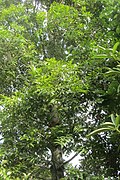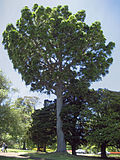Top Qs
Timeline
Chat
Perspective
Agathis
Genus of conifers in the kauri family Araucariaceae From Wikipedia, the free encyclopedia
Remove ads
Agathis, commonly known as kauri or dammara, is a genus of evergreen coniferous trees, native to Australasia and Southeast Asia. It is one of three extant genera in the family Araucariaceae, alongside Wollemia and Araucaria (being more closely related to the former).[1][2] Its leaves are much broader than most conifers. Kauri gum was historically commercially harvested from living New Zealand kauri and from swamp ground.[not verified in body]
Remove ads
Description
Summarize
Perspective
This section needs additional citations for verification. (June 2021) |

Mature kauri trees have characteristically large trunks, with little or no branching below the crown. In contrast, young trees are normally conical in shape, forming a more rounded or irregularly shaped crown as they achieve maturity.[3]
The bark is smooth and light grey to grey-brown, usually peeling into irregular flakes that become thicker on more mature trees. The branch structure is often horizontal or, when larger, ascending. The lowest branches often leave annular branch scars when they detach from the lower trunk.
The juvenile leaves in all species are larger than the adult, more or less acute, varying among the species from ovate to lanceolate. Adult leaves are opposite, elliptical to linear, very leathery and quite thick. Young leaves are often a coppery-red, contrasting markedly with the usually green or glaucous-green foliage of the previous season.
The male pollen cones appear usually only on larger trees after seed cones have appeared. The female seed cones usually develop on short lateral branchlets, maturing after two years. They are normally oval or globe shaped.
Seeds of some species are attacked by the caterpillars of Agathiphaga, some of the most primitive of all living moths.
Remove ads
Uses
This section needs additional citations for verification. (August 2025) |

Various species of kauri give diverse resins such as kauri gum. The timber is generally straight-grained and of fine quality with an exceptional strength-to-weight ratio and rot resistance, making it ideal for yacht hull construction. The wood is commonly used in the manufacture of guitars and ukuleles due to its low density and relatively low price of production. It is also used for some Go boards (goban). The uses of the New Zealand species (A. australis) included shipbuilding, house construction, wood panelling, furniture making, mine braces, and railway sleepers. Due to the hard resin of the wood, it was the traditionally preferred material used by Māori for wooden weapons, patu aruhe (fernroot beaters) and barkcloth beaters.[4]
Remove ads
Evolutionary history
Within Araucariaceae, it is thought that Agathis and Wollemia share a common ancestor which lived between 90 and 55 million years ago, and the two genera form a sister clade to the older Araucaria.[5] The oldest fossils currently confidently assignable to Agathis are those of Agathis immortalis from the Salamanca Formation of Patagonia, which dates to the Paleocene, approximately 64.67–63.49 million years ago. Agathis-like leaves are also known from the slightly older Lefipán Formation of the same region, which date to the very end of the Cretaceous.[6] Some authors have suggested that Agathis is known from earlier in the Cretaceous (Aptian to Cenomanian in North Africa.[7] Other fossils of the genus are known from the Eocene of Patagonia, the Late Paleocene-Miocene of southern Australia, and the Oligocene-Miocene of New Zealand.[8]
Species list
Summarize
Perspective
| Phylogeny of Agathis[9] | |||||||||||||||||||||||||||||||||||||||||||||||||||||||||||||||||||||||||||||||||||||||||||||
|
- Accepted species[1]
- Formerly included[1]
Moved to Nageia
- Agathis motleyi - Nageia motleyi
- Agathis veitchii - Nageia nagi
The placement of the fossil species "Agathis" jurassica from the Late Jurassic of Australia in this genus is doubtful.[10]
Remove ads
Gallery
- Te Matua Ngahere, an A. australis in Waipoua Forest, the oldest (and 2nd largest) tree in New Zealand
- Trunk of the Yakas kauri (7th largest)
- Agathis lanceolata
- Agathis ovata
- Agathis macrophylla
- Agathis robusta
- Agathis borneensis
- Agathis australis male pollen cone
- Scale from Agathis australis female cone
- Agathis australis cone
- Agathis australis leaves and cones
Remove ads
References
External links
Wikiwand - on
Seamless Wikipedia browsing. On steroids.
Remove ads





















